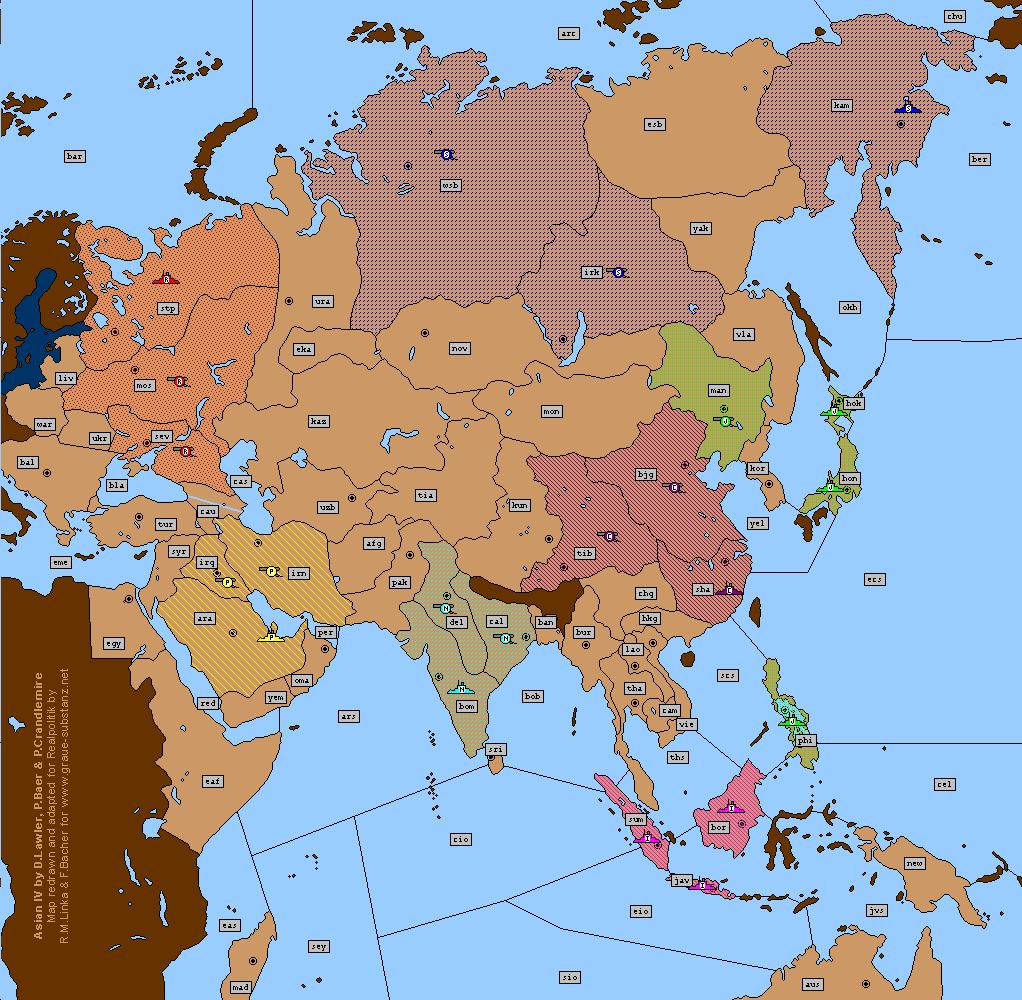Asia
[Description modified from various sources: Diplomatic Pouch (www.diplom.org), Variant Bank (www.variantbank.org), and the Realpolitik info file. For a more detailed description (based on an earlier version of the map), read Pitt Crandlemire's article in the W1996A issue of the DipPouch Zine. Realpolitik files are available for download from Graue-Substanz at www.int.graue-substanz.net].
Asian Diplomacy was originally conceived of and created by David Lawler. It has been updated and modified by Peter Baer and Pitt Crandlemire.
The map extends from Eastern Europe to New Guinea and northern Australia. It incorporates all of Asia plus parts of Africa, Europe, and Oceania. Asian Diplomacy has almost no historical basis.
There are absolutely no rule changes from the standard Dip rulebook. Just a new map.
Canals (in Caucasus and Constantinople) are similar to Constantinople in the regular Vanilla game; i.e. fleets and armies may cross, but only one may be occupying the territory at a time. The Egyptian/Syrian border is similar to the Denmark/Sweden border in the regular Vanilla game; i.e. each has only one coast.
Map clarification: Egypt, Syria, Arabia, and the Red Sea converge at a point; movement is not permitted directly between Egypt and Arabia or Syria and the Red Sea.
Countries and Starting Positions
There are 7 nations. The starting positions are:
China A Beijing A Tibet F Shanghai
India A Calcutta A Delhi F Bombay
Indonesia F Borneo F Java F Sumatra
Japan F Hokkaido F Honshu A Manchuria F Philippines
Russia A Moscow A Sevastopol F St Petersburg
Siberia A Irkutsk F Kamchatka A West Siberia
Persia A Iran A Iraq F Arabia (east coast)
The 18 neutral supply centers are: Australia, Balkans, Burma, Egypt, Korea, Kunlun, Laos, Madagascar, Novosibirsk, Oman, Pakistan, Sri Lanka, Thailand, Turkey, Urals, Uzbekistan, Vietnam, Yakutsk.
Victory Conditions
40 territories are marked as supply centers, and 21 are needed to win.
Errors in the RP Files
1) Yakutsk is not but should be drawn as a supply center (i.e. it does not have a dot). Fortunately, it does behave as one. This problem can be fixed by editing the .bmp file.
2) The map file erroneously treats Hokkaido as being adjacent to Bering Strait but not adjacent to Honshu. This problem can be fixed by changing the adjacency entries for Bering, Hokkaido, and Honshu.
Gameplay Reflections from DC 260 (from its GM)
While the game was enjoyed, players and GM felt the map had imbalances which: (a) favored certain positions, and (b) tended towards a bit of drawishness. Four of the main map design issues were the Caspian Sea, access to neutral centers, China/Japan, and Indonesia.
Caspian Sea: In DC 260, Russia was an early casualty, which led to a Persian/Siberian conflict in the Russian home territories. It turns out that the position of the Caspian Sea (with an untouchable Persian fleet in it) leads to a series of defensive stalemate lines for the Persian player. This is caused in part by the Mediterranean-Black Sea-Caspian Sea line along with the narrow land bridges of Balkans/Turkey and Caucusus/Sevastopol. But it is also caused by the strange shape of Moscow, which not only borders the Caspian Sea but is difficult to flank to the west on account of Livonia and Warsaw. It was felt that Moscow should be subdivided into two or three provinces to increase elbow room.
Access to neutral centers: Siberia, Russia, and Japan have less access to neutral centers. The other powers have Indo-China and the Middle East. Siberia seemed particularly distant. It was suggested that Japan might fare better if its Manchurian army instead started in Korea.
China/Japan: China and Japan are cheek-to-jowl. But Japan holds an upper hand in its fleet supremacy. To make things worse, due to the difficulty of attacking Indonesia or Siberia, China is Japan's easiest source of centers. The two don't need to fight, but the game stacks the deck. Another factor here is the naval congestion -- Sea of Okhotsk and East China Sea could easily be subdivided to provide more maneuverability in the region. [In DC 260, this had late-game influences on the Indonesian-Siberian front as well]. It's an analog to the odd congestion around Moscow.
Indonesia: In the GM's opinion, this is the greatest imbalance of the game. As one player phrased it, the map is arranged in a circle with a big open space in the middle. So, players will likely attack one of two neighbors. But Indonesia stands outside the circle. To further worsen things, Indonesia starts with three fleets and easy access to Indo-China. So, Indonesia has few natural enemies but many easy targets.
In conclusion, the game could use another revision. I'd be curious how it stacks up against Canton and Colonial for balance and game play.
